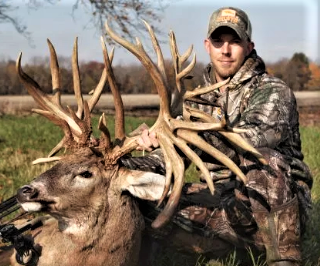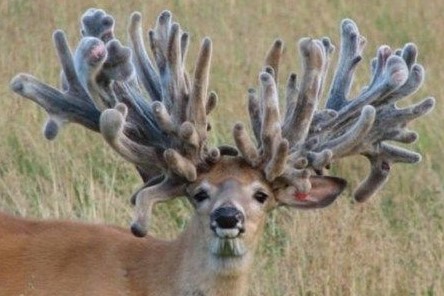26 Feb CRAZY ANTLERS!!!
Non typical buck racks are unusual and amazing. Nature has a way of taking something and making it something unique. Not all deer racks are created equally, and non-typical racks take it to a whole new level.

Years ago, I was hunting with my brother in Baltimore County, Maryland. We found an area with plenty of buck sign and set up along a ridge. The rubs along this ridge were intense and more tore up than usual. Just before dark, I heard my brother shoot. He saw a deer sneaking down the ridge and took the shot. We found the blood trail and followed it into the valley. In low light, the big deer had antlers, so we knew it was a buck. When I grabbed the antler, the entire forest seemed to move. The antler was antlers, the size of a small set of tree roots. I was so startled that I dropped the buck and stepped back.
This was the first non-typical buck that we had encountered. I have only ever seen one other nontypical buck while hunting, in the same area. It turned out that the area we were hunting had historical genetics for this mutation. As big as this buck was, half of the rack had been broken off. The check station aged it as over 7 years old. The buck was past its prime and was still huge.
Non typical antlers mean many things. Antlers become something other than “Typical”. They could be gnarled, fluted, branched, short, scrawny, drop tined, desiccated, or… There are many reasons why antlers can become non-typical.

Genetics This is the first area to look at when examining antlers. Unique antlers mean unique genetics. A buck grows antlers based on the DNA supplied equally from both parents. Sometimes the gene comes from the buck and sometimes from the doe. Each generation does not guarantee a non-typical outcome. It may only show up every so many years. Antler and body development are also related. Based on the gene recipe, some bucks may have a greater chance to be non-typical. Usually, more fawns are born each year than bucks. This may also impact whether an area has non-typical bucks. Antlers may also show up in does that grow antlers. In most cases, the doe antlers remain in velvet due to lack of enough testosterone hormones.
Hormones may also determine the mass or character of non-typical antlers. If nutrition and health are excellent, then the antlers will reflect this. If the opposite is true, energy will be redirected to the rest of the body to survive. Antlers will be reduced.
Therefore, we tend to see unique characteristics such as non-typical antlers and albinism only in core areas. Genetics is the key ingredient
Insects When a buck is in the velvet stage of antler development, blood sucking insects see the velvet covered antlers as a fast food center. Any insect that sucks blood like ticks, mosquitos, flies, or… has an invitation. Some wasps will lay their eggs in the velvet. Later the developing larva will eat its way out, creating a hole in the antler. Dense masses of ticks can also reduce the size of an antler.
Age Older bucks tend to be past their prime. This can result in desiccated, underdeveloped, or unique non-typical antlers. As deer age, their teeth and health wear down. This means that nutrition becomes more of a factor. Antlers become impacted.
Disease CAS or Cranial Abscessation Syndrome can impact antler growth. This is a brain abscess disease caused by bacteria entering the velvet stage antler due to an injury. Pus will also be seen seeping from the pedicle or base of the antler. Any disease will impact the development of antlers. This can misshapen or alter any typical growth.
Trauma If a deer becomes a victim of a car collision or any impact during the Velvet stage of antler growth, the antlers can change. What is unique is that if the deer is injured on the left side, the abnormality antler growth will show up on the opposite side.
Contact When a buck is in their Velvet Stage, any impact, or pressure to the antler, can make it a non-typical. In Europe, some game managers would shoot bird shot at velvet bucks to force them to flee into the woods. The antlers would hit branches and who knows what would happen to become non-typical. Clients wanted unique, not typical. When a buck sleeps in a certain position, or the antler hits a branch or the antler, … So many things can change the soft velvet antler as its growing. I once found a dead buck in the woods with no sign of a wound. Upon closer examination, I noticed that the brow tine had grown back into the buck’s skull. At some point, this headache killed him.
Non-Typical antlers are not typical. This is what interests some hunters. Mounting a unique, one of a kind critter, is special. There is not another that is the same.
Nature is so special.
Montana Grant
For more Montana Grant, find him at www.montanagrantfishing.com.


